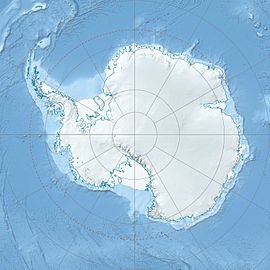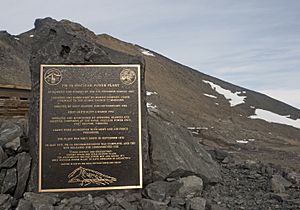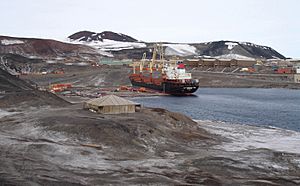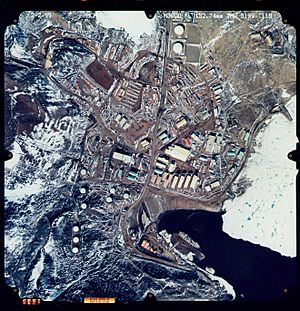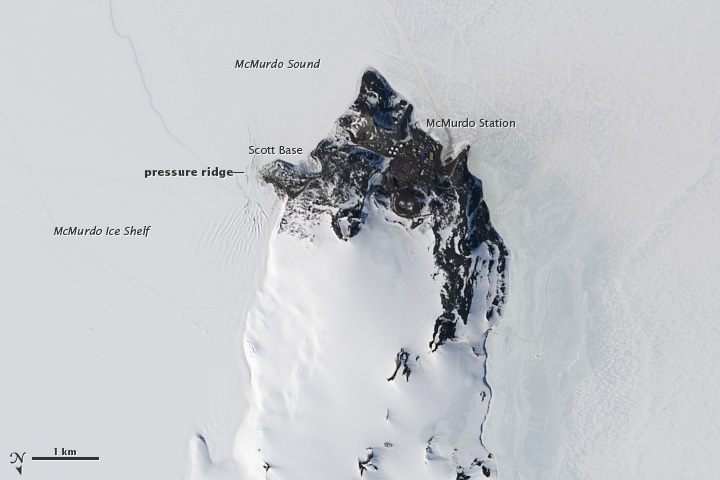McMurdo Station facts for kids
Quick facts for kids
McMurdo Station
|
|
|---|---|
|
Antarctic base
|
|
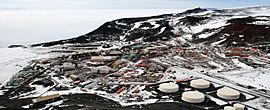
McMurdo Station from Observation Hill
|
|
| Country | |
| Location in Antarctica | Ross Island, Ross Dependency; claimed by New Zealand. |
| Administered by | United States Antarctic Program of the National Science Foundation |
| Established | 16 February 1956 |
| Named for | Archibald McMurdo |
| Elevation | 10 m (30 ft) |
| Population | |
| • Summer | 1,258 |
| • Winter | 250 |
| Time zone | UTC+12 (NZST) |
| • Summer (DST) | UTC+13 (NZDT) |
| Type | All year-round |
| Period | Annual |
| Status | Operational |
| Facilities | More than 85 buildings with facilities that include:
|
| Website | |
McMurdo Station is a science research base for the United States in Antarctica. It is located on the southern tip of Ross Island, right on the coast of McMurdo Sound. This area is also claimed by New Zealand. The station is run by the United States Antarctic Program, which is part of the National Science Foundation.
McMurdo is the largest community in Antarctica. It can host up to 1,258 people. It is one of three US science bases that operate all year. All people and supplies going to or from the Amundsen–Scott South Pole Station must pass through McMurdo first. McMurdo is only 3 kilometers (1.9 miles) from New Zealand's smaller Scott Base.
Contents
History of McMurdo Station
The station gets its name from McMurdo Sound. This sound was named after Lieutenant Archibald McMurdo. He was on the ship Terror in 1841. The Terror and another ship, Erebus, first mapped this area.
The British explorer Robert Falcon Scott set up a base camp here in 1902. He built a cabin called Discovery Hut. This hut is still a historic monument near the water at McMurdo Station. The ground here is made of volcanic rock. It is the southernmost place in the world where ships can reach bare land.
The United States officially opened its first station at McMurdo on February 16, 1956. This was part of a project called Operation Deep Freeze. The US Navy built the base. It was first called Naval Air Facility McMurdo.
McMurdo's Role in Science
McMurdo Station was a main center for US operations during the International Geophysical Year. This was a global science effort from 1957 to 1958. After this, McMurdo became the main hub for US science and support in Antarctica.
The Antarctic Treaty System helps manage life at McMurdo. This treaty was signed by many countries. It sets rules for how countries interact in Antarctica. It also guides daily life for people at McMurdo. The treaty was signed in 1959 and started in 1961.
The first rules for scientific diving were made before 1960. The first dives were recorded in November 1961.
Nuclear Power at McMurdo (1962–1972)
On March 3, 1962, a nuclear power plant called PM-3A started working at the station. This plant was built in parts to make it easy to move and put together. The parts were designed to be small enough to fit on a special aircraft. However, they were actually brought by ship.
The reactor made 1.8 megawatts of electricity. It saved about 1,500 US gallons (5,678 liters) of oil each day. The power was used to make steam for a plant that turned salt water into fresh water. The US Army stopped using the plant in 1972. This was because of ongoing safety issues like cracks and water leaks.
After the nuclear plant closed, diesel generators took over. These generators now provide all the electricity. A new plant also uses regular fuel to make fresh water.
Modern Functions of the Station
As of 2007, McMurdo Station was the largest community in Antarctica. It is a modern science station. It has a harbor, three airfields (two used only in certain seasons), a heliport, and over 100 buildings. One important building is the Albert P. Crary Science and Engineering Center. The station also has the continent's only two ATMs.
Most people at McMurdo are not scientists. They are support staff who help with daily operations. This includes logistics, IT, construction, and maintenance. About 1,000 people live there in summer and 250 in winter.
Scientists and staff are part of the USAP. This program helps organize research and support in Antarctica. Documentaries like Encounters at the End of the World (2007) and Antarctica: A Year on Ice (2013) show life at McMurdo.
Each year, cargo ships bring supplies during Operation Deep Freeze. They deliver 8 million US gallons (30 million liters) of fuel. They also bring 11 million pounds (5 million kg) of supplies and equipment. These ships are run by civilian sailors. They carry everything from mail and food to building materials and science tools. US Coast Guard icebreakers clear a path through the ice for these ships. More supplies and people fly in from Christchurch, New Zealand, to Williams Field.
Between 1962 and 1963, 28 small rockets were launched from McMurdo Station.
McMurdo Station is about 3 kilometers (2 miles) from Scott Base, New Zealand's science station. All of Ross Island is claimed by New Zealand. Some people have criticized the base for its building projects, like the road to the South Pole.
McMurdo Station has worked to improve how it handles waste. This is to follow the Protocol on Environmental Protection to the Antarctic Treaty. This agreement protects Antarctica's environment. It prevents mining and covers things like ocean pollution, animals, plants, and waste. A new waste treatment plant was built at McMurdo in 2003.
In 2009, three wind turbines were installed. They help power McMurdo and Scott Base. This reduces how much diesel fuel is used by 11%. McMurdo Station, also called "Mac-Town," is still the main center for American activities in Antarctica.
On February 15, 2003, about 50 scientists and staff gathered at McMurdo. They shared their opinions about a coming event. This was the only place in Antarctica where such a gathering took place.
Scientific diving continues at McMurdo. From 1989 to 2006, over 10,000 dives were made under the ice. There is a special chamber for divers to use if needed.

Climate at McMurdo
McMurdo has a polar ice cap climate. This means all months have an average temperature below freezing. However, in the warmest months (December and January), the average high temperature can sometimes go above freezing.
The Transantarctic Mountains protect McMurdo from very cold air from inland Antarctica. So, temperatures below -40°C are rare here. The highest temperature ever recorded at McMurdo was 10.8°C on December 21, 1987. In summer, some snow melts. This allows a few types of moss and lichen to grow.
| Climate data for McMurdo Station (extremes 1956–present) | |||||||||||||
|---|---|---|---|---|---|---|---|---|---|---|---|---|---|
| Month | Jan | Feb | Mar | Apr | May | Jun | Jul | Aug | Sep | Oct | Nov | Dec | Year |
| Record high °C (°F) | 10.2 (50.4) |
5.9 (42.6) |
−1.1 (30.0) |
0.0 (32.0) |
−1.3 (29.7) |
3.3 (37.9) |
−4.4 (24.1) |
−2 (28) |
−3.7 (25.3) |
4.5 (40.1) |
10.0 (50.0) |
10.8 (51.4) |
10.8 (51.4) |
| Mean daily maximum °C (°F) | −0.6 (30.9) |
−7.3 (18.9) |
−16.2 (2.8) |
−17.3 (0.9) |
−21 (−6) |
−20.4 (−4.7) |
−21.7 (−7.1) |
−22.7 (−8.9) |
−20.8 (−5.4) |
−14.3 (6.3) |
−6.5 (20.3) |
−0.4 (31.3) |
−14.2 (6.4) |
| Daily mean °C (°F) | −2.8 (27.0) |
−8.8 (16.2) |
−17.3 (0.9) |
−20.9 (−5.6) |
−23.3 (−9.9) |
−22.9 (−9.2) |
−25.8 (−14.4) |
−27.4 (−17.3) |
−25.7 (−14.3) |
−19.4 (−2.9) |
−9.7 (14.5) |
−3.5 (25.7) |
−17.3 (0.9) |
| Mean daily minimum °C (°F) | −4.6 (23.7) |
−11.4 (11.5) |
−21.3 (−6.3) |
−23.4 (−10.1) |
−26.5 (−15.7) |
−26.8 (−16.2) |
−28.4 (−19.1) |
−29.5 (−21.1) |
−27.5 (−17.5) |
−19.8 (−3.6) |
−10.9 (12.4) |
−4.4 (24.1) |
−19.7 (−3.5) |
| Record low °C (°F) | −22.1 (−7.8) |
−25 (−13) |
−43.3 (−45.9) |
−41.9 (−43.4) |
−44.8 (−48.6) |
−43.9 (−47.0) |
−50.6 (−59.1) |
−49.4 (−56.9) |
−45.1 (−49.2) |
−40 (−40) |
−28.5 (−19.3) |
−18 (0) |
−50.6 (−59.1) |
| Average precipitation mm (inches) | 16 (0.6) |
29 (1.1) |
15 (0.6) |
18 (0.7) |
21 (0.8) |
28 (1.1) |
17 (0.7) |
13 (0.5) |
10 (0.4) |
20 (0.8) |
12 (0.5) |
14 (0.6) |
213 (8.4) |
| Average snowfall cm (inches) | 6.6 (2.6) |
22.4 (8.8) |
11.4 (4.5) |
12.7 (5.0) |
17.0 (6.7) |
17.8 (7.0) |
14.0 (5.5) |
6.6 (2.6) |
7.6 (3.0) |
13.5 (5.3) |
8.4 (3.3) |
10.4 (4.1) |
148.4 (58.4) |
| Average precipitation days (≥ 1.0 mm) | 2.6 | 4.7 | 3.2 | 4.5 | 5.5 | 5.7 | 4.7 | 4.1 | 3.0 | 3.2 | 2.4 | 2.5 | 46.1 |
| Average snowy days | 12.8 | 17.6 | 17.8 | 16.4 | 16.2 | 15.6 | 15.3 | 14.5 | 13.3 | 14.5 | 13.5 | 13.8 | 181.3 |
| Average relative humidity (%) | 66.7 | 65.2 | 66.6 | 66.6 | 64.2 | 62.4 | 60.2 | 63.4 | 55.8 | 61.4 | 64.7 | 67.0 | 63.7 |
| Source 1: Deutscher Wetterdienst (average temperatures) | |||||||||||||
| Source 2: NOAA (precipitation, snowy days, and humidity data 1961–1986), Meteo Climat (record highs and lows) | |||||||||||||
Communication at the Station
McMurdo Station has good ways to communicate with the outside world. It gets Internet and phone service through satellites. These signals go to Sydney, Australia, and then to the US. A satellite dish at Black Island provides 20 Mbit/s Internet. Phone calls can be made to and from the US. Inside the station, people use VHF radios to talk to each other.
For a while, McMurdo had Antarctica's only TV station, AFAN-TV. It showed old programs. Now, McMurdo gets three channels from the US military's American Forces Network. It also gets news from Australia and New Zealand. TV signals come by satellite to Black Island. Then, they are sent 25 kilometers (15 miles) by microwave to McMurdo.
Getting Around McMurdo

Surface Travel
McMurdo has the southernmost harbor in the world. Many vehicles, both for roads and off-road, move people and supplies around the station. One special vehicle is called Ivan the Terra Bus. There is also a road from McMurdo to New Zealand's Scott Base and to the South Pole. This road is called the South Pole Traverse.
Air Travel
McMurdo is served by three airports during different seasons:
- Phoenix Airfield (ICAO: NZFX) is a runway made of packed snow. It replaced Pegasus Field in 2017.
- Sea Ice Runway (ICAO: NZIR) is built each year on the sea ice near McMurdo.
- Williams Field (ICAO: NZWD) is a permanent snow runway.
Historic Places to See
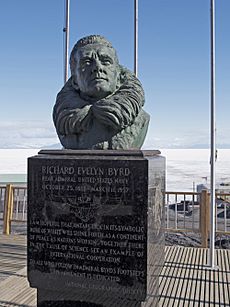
The Richard E. Byrd Historic Monument was put up at McMurdo in 1965. It has a bronze statue of his head on black marble. It tells about his amazing explorations of the poles. This monument is now a Historic Site or Monument (HSM 54).
The bronze Nuclear Power Plant Plaque is a special sign. It is on a large rock on Observation Hill. This is where the nuclear power plant used to be. The sign talks about the achievements of Antarctica's first nuclear power plant. It is also a Historic Site or Monument (HSM 85).
Points of Interest
Here are some interesting places at McMurdo Station:
- Albert P. Crary Science and Engineering Center (CSEC)
- Chapel of the Snows Interfaith Chapel
- Observation Hill
- Discovery Hut, built during Scott's expedition in 1901–1903
- Williams Field airport
- A memorial plaque for three airmen who died in 1946 while mapping the area
- Ross Island Disc Golf Course
See also
 In Spanish: Base McMurdo para niños
In Spanish: Base McMurdo para niños


